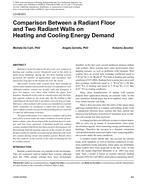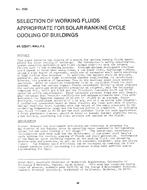Historically, many ancient civilizations erected buildings that happened to have high thermal inertia. In places with high daily amplitude of air temperature and intense solar radiation, buildings made of heavy elements with high thermal capacity showed improved interior thermal environment conditions. Due to environmental concerns, recent studies have taken up this concept, indicating its potential in improve thermal comfort while reducing energy consumption in HVAC in small buildings exposed to various different weather conditions. Other studies have also revealed the main factors affecting building thermal inertia. One that stands out is the position of thermal insulation in the building envelope, which provides different thermal responses of buildings for the same value of thermal resistance. In Brazil, many air-conditioned office buildings have low thermal inertia prioritizing, instead, the thermal insulation of the envelope, characterized by maximum values of thermal transmittance, in accordance with Brazilian legislation for energy efficiency.This work presents an analysis of the energy performance of a small office building located in the city of São Paulo, considering eight different kinds of walls, with the same thermal resistance, varying the effective thermal capacity by changing the position of the insulating layer. The building thermal response was obtained by computer simulations using the EnergyPlus software, considering various conditions of occupancy of the building and air-conditioning.The results show that the building had better energy performance with walls of greater thermal capacity in all situations. We conclude that in small office buildings, exposed to the climatic conditions of cities like Sao Paulo, it is possible to improve the buildings thermal performance considering not only the minimum values of thermal walls resistance, as required by specific legislation, but also higher values of thermal capacity.
Citation: First International Conference on Energy and Indoor Environment for Hot Climates, Doha, Qatar, February 2014
Product Details
- Published:
- 2014
- Number of Pages:
- 8
- File Size:
- 1 file , 1.1 MB
- Product Code(s):
- D-2014FICEConf-13-3


